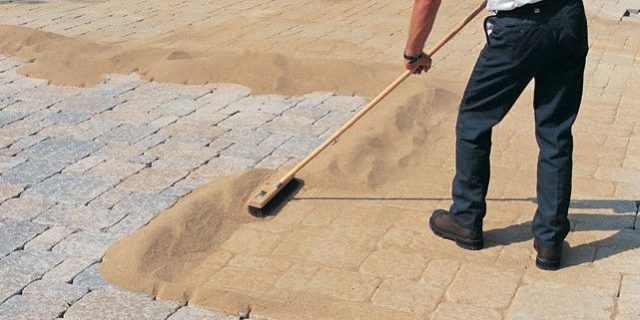Paver sanding is a crucial aspect of maintaining the beauty and functionality of your outdoor spaces. Whether you have a driveway, patio, or walkway made of pavers, regular sanding ensures that these areas remain stable, weed-free, and visually appealing. This article delves into the intricacies of paver sanding, its benefits, and the steps involved in the process. By understanding the importance of paver sanding, you can keep your outdoor spaces in top condition for years to come.
Understanding Paver Sanding
What is Paver Sanding?
Paver sanding involves filling the joints between pavers with sand to lock them in place and prevent shifting. This process enhances the stability and durability of the paver surface. There are various types of sand used for this purpose, including polymeric sand, joint sand, and masonry sand. Each type has its unique properties and benefits, making it suitable for different applications.
Why Paver Sanding is Necessary
Paver sanding is essential for several reasons. It helps prevent weed growth by filling the gaps where weeds could take root. Additionally, it improves the stability and interlock of the pavers, reducing the likelihood of movement or settling over time. Furthermore, paver sanding enhances the appearance of your outdoor spaces by creating a smooth, uniform surface.
Types of Paver Sand
There are three primary types of paver sand:
- Polymeric Sand: This sand contains additives that bind the grains together when activated with water, creating a solid, weed-resistant joint.
- Joint Sand: A finer sand that fills the gaps between pavers, offering basic stability and weed prevention.
- Masonry Sand: Coarser than joint sand, masonry sand is often used in larger joints and provides a robust foundation for paver installations.
Preparing for Paver Sanding
Assessing the Condition of Pavers
Before starting the paver sanding process, it’s important to assess the condition of your pavers. Look for signs of damage, such as cracks or chips, and clean the surface thoroughly to remove dirt and debris. Identifying problem areas early ensures a smoother sanding process and better results.
Choosing the Right Sand
Selecting the appropriate sand for your project is crucial. Consider factors like the size of the joints, the type of pavers, and the desired level of weed resistance. Comparing different types of sand helps you choose the best option for your specific needs, ensuring effective and lasting results.
Gathering Necessary Tools and Materials
To perform paver sanding effectively, gather all necessary tools and materials beforehand. This includes a broom, a pressure washer, a plate compactor, safety gear, and, of course, the chosen sand. Preparing your work area and having all tools at hand will streamline the process and help you achieve better results.
The Paver Sanding Process
Cleaning the Paver Surface
A clean surface is essential for effective paver sanding. Start by removing any debris, dirt, or existing sand from the paver joints. Using a power washer can help achieve a thorough clean, ensuring that the new sand adheres properly and fills the joints completely.
Applying the Sand
Once the surface is clean, you can begin applying the sand. Spread the sand evenly over the paver surface, using a broom to ensure it fills all the joints. Take your time to fill the joints properly, as this will enhance the stability and longevity of the paver installation.
Compacting the Sand
Compacting the sand is a crucial step in the paver sanding process. Use a plate compactor to ensure the sand settles firmly into the joints. This step helps achieve a stable, durable surface that resists movement and weed growth. Proper compaction also enhances the overall appearance of the pavers.
Sealing the Pavers
Benefits of Sealing
Sealing your pavers after sanding offers several benefits. It protects the surface from stains, enhances the color and appearance of the pavers, and extends their lifespan. Sealing also helps lock the sand in place, further preventing weed growth and erosion.
Choosing the Right Sealer
There are various types of sealers available, including water-based and solvent-based options. Consider factors such as the type of pavers, environmental conditions, and desired finish when selecting a sealer. Choosing the right sealer ensures optimal protection and enhances the appearance of your pavers.
Applying the Sealer
Before applying the sealer, ensure the paver surface is clean and dry. Follow the manufacturer’s instructions for application, using appropriate safety measures. Typically, the sealer is applied with a roller or sprayer, and it should be left to cure according to the recommended time to achieve the best results.
Maintaining Sanded Pavers
Regular Cleaning
Regular cleaning is essential for maintaining the appearance and functionality of sanded pavers. Use a broom or a leaf blower to remove debris and prevent build-up. Periodic power washing can also help maintain a clean, attractive surface.
Reapplying Sand
Over time, the sand in the paver joints may erode or settle. Signs that re-sanding is needed include visible gaps between pavers and loose sand. Depending on wear and tear, re-sanding may be necessary every 1-3 years to maintain stability and appearance.
Inspecting for Damage
Regular inspections help identify and address damage early. Look for signs of wear, such as cracks or loose pavers, and repair them promptly. Preventative measures, such as sealing and proper maintenance, can help extend the lifespan of your paver installation.
Benefits of Professional Paver Sanding
Expertise and Experience
Hiring professional paver sanding services brings the advantage of expertise and experience. Professionals have the knowledge and tools to perform the job efficiently and effectively, ensuring high-quality results. They can also provide valuable advice on maintenance and care.
Time and Effort Savings
Professional paver sanding services save you time and effort. The process can be labor-intensive and time-consuming, especially for larger areas. Professionals handle all aspects of the job, from preparation to clean-up, allowing you to enjoy the results without the hassle.
Quality of Results
Professional paver sanding ensures superior quality and durability. Experienced contractors use the best materials and techniques to achieve a stable, long-lasting surface. Testimonials and case studies often highlight the significant difference in results between DIY and professional sanding.
DIY Paver Sanding Tips
Planning Your Project
Planning is crucial for a successful DIY paver sanding project. Set realistic goals, create a timeline, and budget for necessary materials and tools. Thorough planning helps ensure a smooth process and satisfactory results.
Avoiding Common Mistakes
Common mistakes in DIY paver sanding include overfilling joints, skipping compaction, and using the wrong type of sand. Avoid these errors by following best practices and guidelines. Proper technique ensures better stability and appearance.
Safety Precautions
Safety is paramount when performing paver sanding. Wear protective gear, such as gloves and safety glasses, and handle tools carefully. Work in suitable weather conditions to avoid accidents and achieve the best results.
Environmental Considerations
Eco-Friendly Sand Options
Choosing eco-friendly sand options supports sustainable practices. Some sands are made from recycled materials or sourced sustainably. Using eco-friendly sand reduces environmental impact and promotes responsible landscaping.
Waste Disposal
Proper disposal of old sand and debris is essential. Recycle materials where possible and follow local regulations for waste disposal. Responsible disposal minimizes environmental impact and keeps your project environmentally friendly.
Impact of Sealing Products
Consider the environmental impact of sealing products. Eco-friendly sealers with low VOC emissions are available and provide effective protection with minimal environmental harm. Choosing these products supports sustainable landscaping practices.
Enhancing Aesthetic Appeal
Choosing the Right Sand Color
Selecting the right sand color enhances the aesthetic appeal of your pavers. Match the sand color with your pavers or create visual contrast for a striking look. Popular color choices include natural, tan, and gray.
Creative Sanding Patterns
Experimenting with creative sanding patterns can add a unique touch to your outdoor spaces. Design patterns that complement the overall landscaping and architecture. Combining different sand types and colors can create visually appealing designs.
Complementary Landscaping
Integrating your pavers with complementary landscaping elements enhances the overall aesthetic. Add plants, lighting, and other features to create a cohesive and inviting outdoor space. Thoughtful landscaping complements the beauty of well-maintained pavers.
Cost Considerations
Budgeting for Paver Sanding
Budgeting is crucial for any paver sanding project. Consider the cost of materials, tools, and any professional services. Planning for these expenses ensures you stay within budget and achieve the desired results.
Cost-Benefit Analysis
Performing a cost-benefit analysis helps determine the value of professional services versus DIY. Consider factors like time, effort, and quality of results. Long-term savings from proper maintenance and increased property value often justify the investment in professional services.
Finding Affordable Services
To find affordable paver sanding services, obtain competitive quotes from multiple contractors. Negotiate pricing and ask about financing options. Choosing a reliable, cost-effective service provider ensures quality results without breaking the bank.
Common Myths About Paver Sanding
Myth: All Sands Are the Same
Not all sands are the same. Different types of sand have unique properties that affect stability, appearance, and weed resistance. Choosing the right sand for your project is crucial for achieving the best results.
Myth: Sanding is a One-Time Task
Paver sanding is not a one-time task. Regular maintenance, including re-sanding, is necessary to keep your pavers stable and attractive. Understanding the importance of ongoing maintenance ensures long-term benefits.
Myth: DIY Sanding is Always Cheaper
While DIY sanding can save money upfront, hidden costs like tools, materials, and potential mistakes can add up. Professional services often provide better long-term value due to superior quality and durability.
FAQs
- What type of sand is best for paver sanding?
Polymeric sand is often recommended for its stability and durability.
- How often should paver sanding be done?
Generally, every 1-3 years, depending on wear and tear.
- Can I use regular sand for paver joints?
While possible, it’s not recommended due to lack of stability and weed growth.
- Do I need to seal my pavers after sanding?
Sealing is optional but highly recommended for protection and longevity.
- Is professional paver sanding worth the cost?
Yes, for quality results and time savings, professional services are beneficial.
- Can I re-sand pavers myself?
Yes, with the right tools and preparation, DIY is feasible.
- How do I prevent weeds in paver joints?
Using polymeric sand and proper maintenance helps prevent weed growth.
- What are the signs that my pavers need re-sanding?
Loose sand, weeds, and shifting pavers indicate the need for re-sanding.
- How long does paver sanding take?
The time varies depending on the size of the area, but generally, a few days.
- Can sanding improve the appearance of old pavers?
Yes, it can refresh and stabilize the pavers, enhancing their look.
Conclusion
Paver sanding is an essential maintenance task that enhances the stability, durability, and appearance of your outdoor spaces. Whether you choose to do it yourself or hire professional services, understanding the process and its benefits ensures your pavers remain in top condition. Regular maintenance, including re-sanding and sealing, helps extend the lifespan of your pavers and keeps your outdoor areas looking beautiful. Embrace paver sanding as a key component of your landscaping routine and enjoy the long-term benefits it brings.

